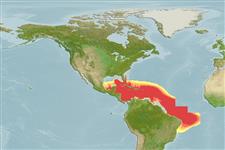>
Atheriniformes (Silversides) >
Atherinopsidae (Neotropical silversides) > Menidiinae
Etymology: Melanorhinus: Greek, melan, -anos = black + Greek, rhinos = nose (Ref. 45335).
More on author: Poey.
Environment: milieu / climate zone / depth range / distribution range
Οικολογία
Θαλασσινό(ά). Tropical
Western Atlantic: Bahamas, Cuba, St. Martin, and Panama. Antilles (Ref. 26938)
Μέγεθος / Βάρος / Age
Maturity: Lm ? range ? - ? cm
Max length : 7.5 cm TL αρσενικό/απροσδιόριστο; (Ref. 5521)
Μαλακές εδρικές ακτίνες: 22 - 24.
Oceanic species (Ref. 5217).
Life cycle and mating behavior
Maturities | Αναπαραγωγή | Spawnings | Egg(s) | Fecundities | Προνύμφες
Böhlke, J.E. and C.C.G. Chaplin, 1993. Fishes of the Bahamas and adjacent tropical waters. 2nd edition. University of Texas Press, Austin. (Ref. 5521)
IUCN Red List Status (Ref. 130435)
Threat to humans
Harmless
Human uses
Εργαλεία
Special reports
Download XML
Διαδικτυακές πηγές
Estimates based on models
Preferred temperature (Ref.
123201): 23.5 - 27.6, mean 26.5 °C (based on 86 cells).
Phylogenetic diversity index (Ref.
82804): PD
50 = 0.6250 [Uniqueness, from 0.5 = low to 2.0 = high].
Bayesian length-weight: a=0.01122 (0.00514 - 0.02450), b=3.04 (2.87 - 3.21), in cm total length, based on all LWR estimates for this body shape (Ref.
93245).
Τροφικό Επίπεδο (Ref.
69278): 3.1 ±0.2 se; based on size and trophs of closest relatives
Ελαστικότητα (Ref.
120179): Υψηλό, ελάχιστος χρόνος για διπλασιασμό πληθυσμού < 15 μήνες (Preliminary K or Fecundity.).
Fishing Vulnerability (Ref.
59153): Low vulnerability (10 of 100).
